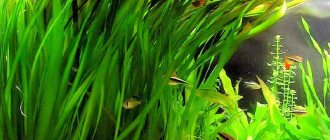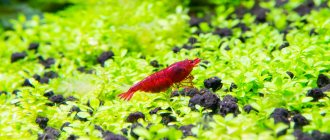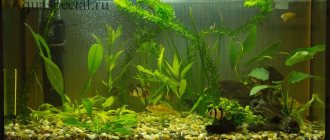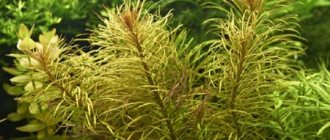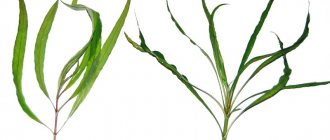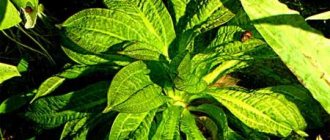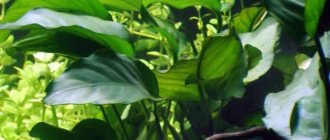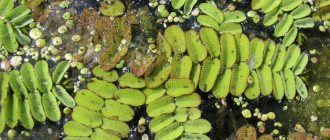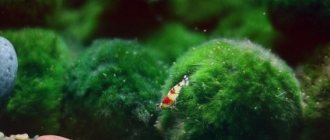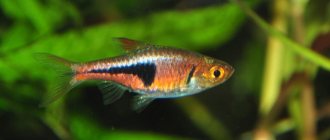What kind of dwarf plant is this?
Anubias nana is a small plant of the Araceae family, which includes a variety of species of marsh plants, tropical shrubs and vines. Due to its exceptional unpretentiousness and excellent decorative qualities, nana is successfully grown in aquariums, paludariums and wet greenhouses.
The Latin name of Anubias nana is Anubias barteri var. nana . Another name more common among aquarists is “Dwarf Anubias”.
Anubias nana is perhaps the hardiest of the so-called “amphibian plants” (that is, those that grow well in both water and air). This endurance is due to the extreme living conditions to which the nana has adapted in nature.
Anubias nana easily tolerates long transportation, prolonged existence without lighting and water, and serious damage to the root system.
Finding itself in unfavorable conditions, this hydrophyte stops its growth and development until it adapts to new conditions.
History and geography
The homeland of this hydrophyte is the tropical regions of West Africa (Cameroon). There, Anubias prefers coastal areas of small reservoirs, which dry up during drought and overflow during the rainy season. In nature, it rarely takes root in the ground, preferring tree roots and stones. Having experienced constant changes in living conditions, this plant has developed high adaptability, resistance to mechanical stress and a strong root system, allowing it to easily take root under any circumstances and withstand the onslaught of frequent floods.
Anubias nana was discovered in the mid-19th century in the vicinity of the famous Victoria Falls. A scientific description of the plant was given in 1899 by the German phytogeographer Adolf Engler. However, for a long time it was believed that nana would never take root in aquariums, being a tropical plant and preferring the softest water possible.
Description of appearance
Dwarf Anubias differs from other representatives of Anubias, first of all, in its small size (average height - up to 12 cm). Another important difference is the relatively small leaves of Nana with a characteristic shape. Tough and very dense, they are located on a shortened stem, have a rich green color and look very decorative. Leaf blades are oval in shape with rounded tips . Their average sizes are up to 8 cm in length and up to 4 cm in width.
The root system of the plant is highly branched and creeping. Slowly growing, Nana covers the bottom with a dense green carpet, which serves as an excellent shelter for many inhabitants of the aquarium.
In greenhouse conditions, dwarf Anubias grows noticeably faster, develops larger forms and blooms more often. Nana flowers resemble small white-green koala flowers in appearance, which eventually turn completely white. However, in aquarium conditions, the seeds do not develop. The flower, having lived for several weeks, loses its decorative effect and dies.
Important! Not all types of Anubias offered by specialized stores are adapted to life in water. Only round and long-leaved representatives of Anubias are suitable for decorating aquariums.
Pros and cons of the plant
In addition to remarkable endurance and adaptability, Anubias nana has other positive features:
- comparative ease of care;
- compatibility with all types of plants, fish and snails;
- its small size and decorative effect make it possible to use nana in the design of any aquarium;
- vegetative propagation;
- no need to prune the plant.
However, you need to remember the negative aspects of this plant:
- high price;
- very slow growth rate;
- intolerance to normal lighting;
- high probability of algae fouling and painful reactions to them;
- increased requirements for water purity.
Habitat
The first samples were discovered by scientists in the tropics of Africa in the western part of the continent.
- Most often, Anubias can be found in natural conditions in shady, marshy lands. Their favorite place to grow is on the banks of tropical rivers with poor lighting. Being emergent plants, they are also found in coastal areas, where they receive the necessary amount of moisture during the rainy season. Sometimes they are found on various stones and snags, which are located directly in the water column.
- There is a significant presence of Anubias in Cameroon; most often it can be found near the famous Victoria Falls. Very soft water prevails here, which does not contain magnesium and calcium molecules, as well as a variety of nitrates and nitrites. Such places are ideal for the development of plants similar to Anubias.
- This representative of the underwater world can also be found in running water. In such places it forms a continuous carpet, which is decorated with driftwood and stones located at the bottom. Many owners have adapted to growing them at home. Often in aquariums you can find not only this exotic representative of the flora, but also such an aquatic plant as Bolbitis heudelotii.
Varieties and their photos
As a result of breeding work with dwarf anubias, several new varieties have appeared, differing in the sizes and shapes of leaf blades and roots. The most popular of them:
Bonsai (Anubias barteri var. nana Bonsai)
This is an even more miniature plant (the height of the bush is up to 4 cm), intended for decorating nano-aquariums. Nana Bonsai differs from other subspecies of Anubias in its small, waxy, ovoid leaves, the color of which varies from light green to deep dark green. It grows in small bushes and has a rather weak root system.
This variety is rightfully considered the most beautiful of the Anubias. At the same time, it retains the endurance and unpretentiousness characteristic of all nanas.
Petit (Anubias barteri var. nana “petit”)
The rarest variety of Nana, usually growing slightly taller than Nana Bonsai (up to 5 cm). The leaf blades of Nana Petit are also several centimeters larger, are always dark green and have a more rounded shape. This hydrophyte grows widely and forms miniature thickets at the bottom.
Nana petite is more picky in care, does not bloom at all in aquariums, but is hardy and adapts well to a wide variety of conditions.
There are other subspecies of Anubias nana:
- Anubias nana especial;
- Anubias "nangi";
- Golden Anubias (Anubias barteri var. “nana gold”).
Diseases
Anubias are strong and hardy underwater inhabitants. It is for these qualities that aquarists love flowers so much, but sometimes the green inhabitants get sick. To avoid the death of flowers, you should know what are the characteristic diseases of Anubias in the aquarium:
- Rotting and destruction of the stem - this problem occurs due to poor performance of the filtration unit or rare changes of liquid in the tank. If rotting has already begun, it will be difficult to save the plant.
- Rusty spots and plaque on the leaves, which disfigure the foliage and the appearance of green bushes, eventually turn into large holes on the leaves. Factors that provoke the appearance of rust are considered to be rare fluid renewal, a contaminated tank and the accumulation of fish waste.
- Deformation of foliage - appears due to incorrectly selected levels of lighting.
In other words, plant diseases mainly develop due to insufficient care for the green pet, so it is extremely important to carefully monitor the cleanliness of the aquatic environment and the aquarium as a whole.
Anubias are attractive plants, among which every fan of the underwater world will be able to choose a variety to their liking. Given its excellent decorative characteristics, stability and unpretentiousness, the plant is considered one of the most popular aquarium flora species.
How to maintain?
Dwarf anubias is one of the most unpretentious amphibian plants and it has minimal requirements for living conditions.
Temperature
- Optimal temperature: 24-27°C.
- However, Nana tolerates well a decrease to 18° and an increase to 35°.
Water
- Requires weekly water changes (25% of total volume) and a good filtration system.
- Water hardness can vary from 6° to 20°dGH (but preferably lower).
- Optimal pH level: 6-9.
Composition and amount of soil
The soil and the thickness of its layer are not of particular importance for the nana. The strong root system of this plant takes root well in any conditions and tolerates mechanical damage well. The following composition is considered ideal:
- medium-sized pebbles (5-7 mm);
- peat;
- laterite;
- balls of blue clay.
The optimal thickness of the soil layer for better plant nutrition is 5 cm.
Advice! Young nanas with a weak root system are planted for 2-3 weeks in soil consisting of a layer of pebbles, a layer of garden soil, and another layer of pebbles on top. This composition accelerates the growth and development of the plant.
Lighting
Dwarf Anubias does not tolerate bright, direct light. It is advisable to keep it in dimly or moderately lit aquariums . As a last resort, you can plant nana in the shade of other plants.
However, the duration of daylight should still be at least 10-12 hours.
Feeding
This plant feels great without fertilizing. Especially if there are fish in the aquarium (the organic remains of their vital activity serve as sufficient fertilizer).
If desired, you can use such fertilizers as Florastim, Tetra Planta Min, Kemira-Lux . But it is recommended to apply them no more than once a month and in a dosage half as much as recommended by the manufacturer. Dwarf Anubias is characterized by slow growth and development; it does not require a lot of fertilizer.
Trimming
Dwarf Anubias is known for its extremely slow growth, so it requires virtually no pruning. It is recommended to carry it out when the leaves appear too large and the growth rate is too slow.
Step-by-step instruction:
- for better and easier work with nana, you should prepare special scissors for aquarium plants (curved);
- before pruning, it is recommended to disinfect the tool and make sure it is sharp (pruning should occur without crushing or splitting the plant tissue);
- carefully trim the rhizome near the growth point (after the largest leaves), without removing the plant from the ground;
- cuttings of roots, leaves and other small debris that often appears in the aquarium after trimming should be removed using a net (smaller particles will be removed by a filter);
- after pruning, the root begins to branch intensively, the plant becomes more lush and grows noticeably faster.
Important! Under no circumstances should you trim the leaves of a dwarf anubias, as this will lead to rotting of the remaining part of the leaf blade.
Transfer
Even adult dwarf anubias tolerates transplantation well.
Step-by-step instruction:
- first you should carefully examine the hydrophyte and assess the condition of its root system;
- then the plant is carefully separated from the substrate (if the nana is firmly rooted, the roots can be carefully trimmed);
- after this, the anubias is planted in a new place (due to the slow growth rate, the first leaves will not appear soon, the plant needs some time to adapt).
Description and characteristics of the plant
It is an evergreen creeping plant with thick roots and small internodes. The petioles may be covered with short spines. The leaves are lanceolate, dense, oval, covered with a glossy film. Each branch contains 1-3 inflorescences. The inflorescence cover is oval and opens strongly during the flowering period.
It has a uniform color, most often cream or green. When the fruits ripen, the cover closes. The plant does not have a perianth; the flowers are unisexual. The fruits are berries that have an obovate or compressed spherical shape. The seeds are small, semi-cylindrical. Anubias is a low-growing shrub, but many species reach the water surface.
When planting, the rhizome is not buried in the ground, but placed on top or attached to various decorations. Anubias requires a nutrient substrate. Fertilizer is applied once a month. Reproduction is carried out by dividing the rhizome. When exposed to excessive light, the leaves turn blue-green, indicating algae in the aquatic environment. Because of this, the plant may die.
Reproduction and planting
Dwarf Anubias reproduces vegetatively and by seeds. However, the latter method is only possible in a humid greenhouse.
Step-by-step reproduction instructions:
- From time to time, adventitious buds are formed on the rhizome of the plant, from which small shoots with leaves and thin roots develop;
- as soon as 4-5 leaves appear on such a cutting, it must be carefully separated from the main rhizome;
- then the shoot is planted in a prepared substrate (small pebbles, peat, river sand and turf soil in equal proportions).
Anubias roots penetrate shallowly into the substrate. When planting the rhizome, the plant must remain above the surface of the soil (otherwise it may rot). Small roots are only lightly sprinkled with soil.
If you need to plant a dwarf anubias on a snag or porous stone, experienced aquarists advise temporarily tying the plant to a new substrate with fishing line or pressing it with a large stone so that the hydrophyte does not float up. After 2-3 weeks, Nana will take root firmly enough and there will be no need for additional fastenings.
Priming
Rooting this variety of anubias into the ground is contraindicated; it is necessary to make sure that the rhizome is above the soil thickness, otherwise the root system will inevitably begin to rot. It would be best to secure the bush of this plant to some driftwood using threads. Subsequently, when the roots of the plant wrap around the snag, the threads can be removed.
You can leave Anubias nana-petite lying on the ground, leaving the rhizome on top and only slightly deepening the root branches. Additional fertilizing is usually not required; the natural siltation of the soil is sufficient. Subsequently, the root system, as it develops, slightly “lifts” the entire plant, and the base, made up of intertwined roots, is well suited as a refuge for small fish.
Compatibility with fish
Anubias nana easily gets along with almost all types of fish. This is an ideal plant for aquariums with cichlids, catfish, goldfish, abramites and other herbivorous fish. The hard leaves of Nana are not in demand among them, and this makes it possible to combine voracious fish and real living vegetation in one aquarium.
Many aquarists do not recommend keeping Anubias nana together with bottom-dwelling fish that have a habit of loosening the soil (Corydoras, Ancistrus, Agamixis, Botia). The cloudy suspension formed as a result of their activity clogs the pores of the plant and does not have the best effect on the health of the plant.
Important! In an overcrowded aquarium with an insufficient level of filtration, the pores of the plant also very often become clogged with small particles of vital activity, which leads to the death of the plant.
Main lighting requirements
Anubias nana does not belong to the category of light-loving aquarium crops. In the summer, natural sunlight will be sufficient for the plant to fully develop. In winter and autumn, weak fluorescent light bulbs can be used for these purposes.
With excessively intense additional lighting, Anubias can be affected by parasitic algae. In addition, when using artificial lighting, it is important to ensure that its sources are not located too close and do not leave burns on delicate, sensitive leaves.
Therefore, in bright light, it is recommended to place the plant in shaded areas of the aquarium. The recommended length of daylight for Anubias is approximately 10 hours throughout the day.
Use in aquarium design
Dwarf Anubias looks most impressive in the foreground, successfully creating the illusion of deep perspective even in a small aquarium. Often the dense carpet of this plant is successfully used to imitate “hills” and “valleys” (especially in combination with tall plants in the background). Thus, the space of the aquarium visually expands.
Anubias nana is also great for covering any vertical surfaces. By attaching it to a piece of driftwood or a large rock, you can position the nana above the water's edge or submerge it only partially in the water. This spectacular move, thanks to the amphibious nature of the nana, is often used by aquatic designers.
Dwarf Anubias is most often combined with other types of Anubias (Nana Bonsai or Giant Anubias). also go well with this hydrophyte:
- Aponogeton;
- Bagopa;
- Cabomba;
- Cyperus Helfera;
- Cryptocoryne;
- Echinodorus;
- Hygrophila.
Types of aquarium Anubias
There are many varieties of Anubias, each with its own characteristics.
Anubias Bartera
The leaf blades of this species are thick, the surface is glossy, and the underside is velvety. The leaves are green, heart-shaped at the base with white spots. From below, the leaf blade has a well-defined main vein. The root is thick, creeping, and may be branched. The plant reaches 30 cm and grows very slowly. Tall bushes are planted in an aquatic environment one at a time, small bushes - in groups. Together with such a plant you can keep herbivorous fish.
Anubias the Graceful
A graceful rare variety of Anubias, large and very impressive.
This plant has green leaves that grow up to 40 cm. They have a rounded base and a pointed tip. The thickness of the root is 1.5 cm. The peduncle can grow up to 7-14 cm. The spadix has a large number of buds. The plant blooms from February to early summer.
It is recommended to keep the bush in a wide aquarium. After landing, it takes some time to acclimatize. This is a tall plant that is recommended to be placed in the background. It grows slowly.
If the water is cloudy, through holes begin to form on the leaves. Loves diffused light. Prefers soil made of sand, clay and humus of beech leaves.
Anubias varifolia congo
The leaves are lanceolate or ellipsoid, leathery, green in color, grow up to 40 cm. The tips are sharp, the base is rounded and pointed, the edges are slightly wavy. The leaf blades have prominent lateral and main veins. The flowers are small, united into a spadix. The root is thick, fleshy, and may be branched. The bush can grow up to 70 cm.
Characterized by slow growth. It should be planted in a large container. Placed in the background. Can be kept with herbivorous fish. If a peduncle appears, get rid of it, because the anubias greatly weakens during flowering.
Anubias variegata needs sufficient free space.
Anubias nana dwarf
This is a low plant - about 12 cm. The stem is short, the leaves are hard, oval, green in color. The root is creeping, covered with leaves along its entire length, and can branch. Such a dwarf bush is most often placed in a prominent place. The root is attached to a stone or driftwood and placed in the ground. As it grows, it forms a dense carpet. The rigidity of the leaves allows it to be kept with cichlids.
Anubias afzeli afzelius
This species has bright green leaves with a rounded top and a sharp tip. They reach a length of 25 cm. The rhizome consists of powerful roots. This is a capricious plant, so it is suitable for cultivation only by experienced aquarists. They plant it at the back near the side wall. When the bush is placed in an aquarium, nutritional supplements are applied under the roots: peat, clay, silt.
Video on the topic
Watch a video about Anubias nana:
Anubias nana, with its compact size, can become an interesting decoration for any aquarium. Not only an experienced aquarist, but also a beginner can easily satisfy its modest requirements. Dwarf Anubias will bring special joy to people who are passionate about aquadesign, but do not have enough time and money for their favorite creativity.
- Related Posts
- Top 14 Popular Anubias Species
- Beautiful tropical plant: Anubias Bartera
Advantages and disadvantages
There is a lover for every aquarium plant. The advantages of this type include the following indicators:
- Resistant to changes in water quality.
- Unpretentiousness to the number of light rays.
- Decorative properties.
- Vegetative propagation.
- Low size: no need to trim bushes.
Disadvantages of Anubias nana include:
- Demanding requirements for tropical climates.
- Slow growth in the absence of soft water.
- Lack of flowering in the aquarium environment.
- The need for nutritious soil.
The advantages and disadvantages of this species are always different for each aquarist. For some aquarium owners, the disadvantages can easily turn into advantages. In any case, this plant has excellent decorative properties and will fit into any aquarium interior. Bright green foliage will add color and mood to your aquarium. It is difficult to find an aquarium species with a more unpretentious character, and if you need green space that will please the eye all year round, Anubias nana is for you.
Maintenance and care
Anubias is extremely common among aquarists of all levels. It is not always found among beginners, since even small bushes are expensive due to the slow growth of the plant. But if you have the desire and opportunity, then you should definitely buy Anubias. It will be a wonderful decoration for the aquarium, and at the same time it will not create problems, since it is very easy to maintain.
In order for the bushes to grow well and not rot, they need to be provided with at least minimal conditions. For example this:
Excessive lighting provokes the appearance of algae on the leaves of anubius.
Minimum amount of light. Yes, most plants need bright light, but Anubias quickly becomes covered with algae (blackbeard) and the leaves rot. Therefore, bushes should be planted at the bottom so that the shadow falls from other plants. For example, a nymph or some large echinodorus (ocelot gold, etc.) is perfect for these purposes. With their leaves they will reach the very surface and block the light. Most plants with such a neighbor will die, but Anubias, on the contrary, will feel great and begin to grow well;
Suitable temperature. Overall, it doesn't really matter. This plant can withstand low temperatures, but of course, warm water is better for it, given that in nature it grows in the tropics. The optimal temperature is 25 degrees. In greenhouses it can be increased to 30, since high humidity is needed there;
Water with a high organic content. But here you need to respect the golden mean. If there are a lot of nitrates and phosphates in the water, the inhabitants may die. However, Anubias has root nutrition and it is desirable for it to have a lot of organic matter in the soil. Therefore, replacements should be carried out regularly, but the siphon, on the contrary, is better done less often. At least in those areas where these bushes grow.
